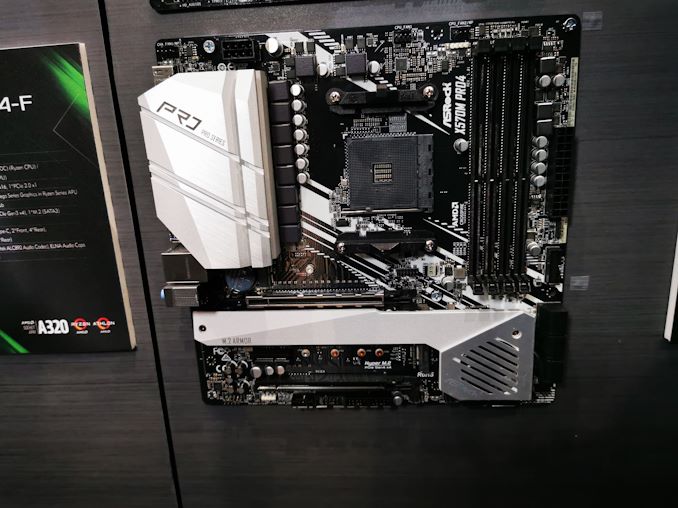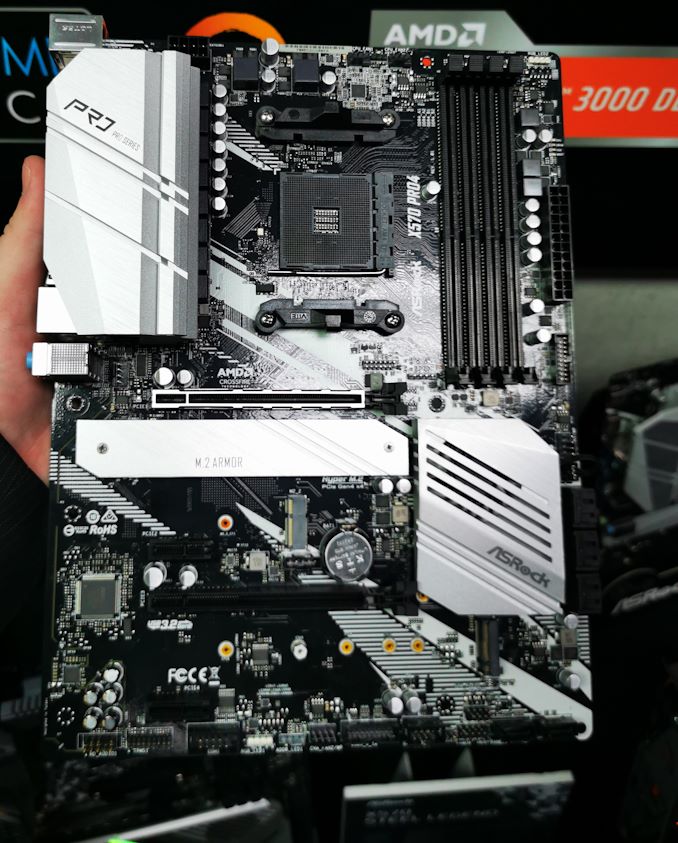The AMD X570 Motherboard Overview: Over 35+ Motherboards Analyzed
by Gavin Bonshor on July 9, 2019 8:00 AM ESTASRock X570 Pro4 & X570M Pro4
ASRock unveiled a number of its X570 models during Computex 2019: a lot of gaming-focused models, and some extremely high-end offerings, but the ATX sized ASRock X570 Pro4 and microATX X570M Pro4 looks set to offer users less bling and more functionality at a lower price point.
Starting with the design of the ASRock X570 Pro4 and X570M Pro4 models, both models use the same silver and black theme throughout, with shining silver heatsinks, and a solid looking aluminium rear panel cover which doubles up as the power delivery heatsink. Both the ATX and microATX models use the same 10-phase power delivery, with both opting to use a single 8-pin 12 V EPS CPU power input. Both have dual PCIe 4.0 M.2 slots with one M.2 heatsink, with eight SATA ports, and both also use an Intel Gigabit LAN port, and a Realtek ALC1220 HD audio codec.
The primary difference aside from the form factor is the ASRock X570 Pro4 naturally has more PCB space for extra PCIe connectivity. This includes two PCIe 4.0 x1 slots on the X570 Pro4 compared to the single PCIe 4.0 x1 on the X570M Pro4, but surprisingly, both feature two full-length PCIe 4.0 x4 slots and an M.2 Key E for users to add their own Wi-Fi/BT module. Both include a DisplayPort and HDMI video output on the rear panel, and four memory slots capable of supporting up to DDR4-4066 with a maximum capacity of up to 64 GB.

ASRock X570M Pro4 microATX motherboard at Computex 2019
The rear panel on both the ASRock X570 Pro4 and X570M Pro4 are identical in terms of connections and includes a single USB 3.1 G2 Type-A, a single USB 3.1 G2 Type-C, six USB 3.1 G1 Type-A ports, and a single Ethernet port powered by an Intel I211AT Gigabit controller. For audio, there are three color coded 3.5 mm audio jacks which is controlled by a Realtek ALC1200 HD audio codec.
It's clear that the X570 Pro4 and X570M Pro4 models are aimed at users with more a more professional focus; this is prevalent in the feature set and the aesthetic. There is nothing flashy about the Pro4, but it does represent a more modest offering in its X570 product stack with the X570 Pro4 priced at $170, with the X570M Pro4 coming in at a slightly higher MSRP of $186












225 Comments
View All Comments
abufrejoval - Tuesday, July 9, 2019 - link
It's amazing how quickly you run out of PCIe lanes, when you don't have switches to multiplex and translate between PCIe revisions and lanes (e.g. PCIe v4 x2 <-> PCIe v2 x8).I find myself using USB 3.x NBase-T NICs and NVMe adapters, simply because they *do* switch.
Bensam123 - Tuesday, July 9, 2019 - link
Maybe a bit more depth on the power delivery page. I have absolutely no idea how to go about parsing what's there. More chokes is better? What denotes a power phase?A5 - Tuesday, July 9, 2019 - link
+1. Some analysis of that information would be helpful.MrSpadge - Tuesday, July 9, 2019 - link
+1bunkle - Wednesday, July 10, 2019 - link
The controller column includes the total number of phases supported split between CPU cores and SoC e.g. (6+1) = 6 CPU phase and 1 SoC phase. More is *usually* better but has diminishing returns regarding tighter and tighter voltage regulation. Some controllers are better than others (can operate at high frequency e.g. 500KHz v 1000KHz, include other features to improve performance) mitigating the need for more phases.Each phase is a buck converter comprised of a low/high side MOSFET (can be integrated in a single package) and choke. Some controllers can support doubling up the PWM signal to driver more MOSFETs. Doublers can also be added as discrete components if not built into the controller.
Current rating of the MOSFET (e.g. Sic639=40A IR3555=60A) indicates the total power deliverable. MOSFETs are not 100% efficient and vary in efficiency. The more current they provide the hotter they get and the less efficient they become, with better MOSFETs producing less heat for a given current. Thus using doubles can improve temperatures and efficiency without the benefits of the tighter voltage tolerance that *real* phases provide.
Hope that’s helpful!
bunkle - Wednesday, July 10, 2019 - link
A lot more detailed explanation: https://en.wikichip.org/wiki/voltage_regulator_mod...bug77 - Tuesday, July 9, 2019 - link
The description for AsRock X570(M) Pro4 says "5 jack + 1 SPDIF". Unfortunately, those boards lack SPDIF and only come with 3 jacks ;)Smell This - Tuesday, July 9, 2019 - link
I'm thinking the *ASRock Thunderbolt AIC* ...https://thunderbolttechnology.net/product/asrock-t...
would cover all your TBT peripheral needs, including optical.
DanNeely - Tuesday, July 9, 2019 - link
Do X570 boards still need an extra chip per USB port to support USB-C reversibility?The additional expense and needed PCB space were cited as among the reasons why earlier generation boards (IIRC both Intel and AMD) almost never had more than 1 C port; but it was never clear to me if that was an inherent implementation penalty for the C port or an artifact of Intel's tech stack being stalled out and AMD outsourcing to ASMedia which built the chipsets on an ancient (55nm) platform.
DigitalFreak - Tuesday, July 9, 2019 - link
Gavin - X370 and X470 only supported PCIe 2.0. The connection between the CPU and chipset was 3.0, but all the ports on the chipset were 2.0.